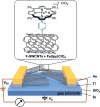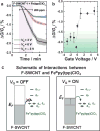Bio-Inspired Carbon Monoxide Sensors with Voltage-Activated Sensitivity
- PMID: 28952172
- PMCID: PMC5658252
- DOI: 10.1002/anie.201707491
Bio-Inspired Carbon Monoxide Sensors with Voltage-Activated Sensitivity
Abstract
Carbon monoxide (CO) outcompetes oxygen when binding to the iron center of hemeproteins, leading to a reduction in blood oxygen level and acute poisoning. Harvesting the strong specific interaction between CO and the iron porphyrin provides a highly selective and customizable sensor. We report the development of chemiresistive sensors with voltage-activated sensitivity for the detection of CO comprising iron porphyrin and functionalized single-walled carbon nanotubes (F-SWCNTs). Modulation of the gate voltage offers a predicted extra dimension for sensing. Specifically, the sensors show a significant increase in sensitivity toward CO when negative gate voltage is applied. The dosimetric sensors are selective to ppm levels of CO and functional in air. UV/Vis spectroscopy, differential pulse voltammetry, and density functional theory reveal that the in situ reduction of FeIII to FeII enhances the interaction between the F-SWCNTs and CO. Our results illustrate a new mode of sensors wherein redox active recognition units are voltage-activated to give enhanced and highly specific responses.
Keywords: Carbon monoxide; carbon nanotubes; iron porphyrin; sensors; voltage-activated.
© 2017 Wiley-VCH Verlag GmbH & Co. KGaA, Weinheim.
Conflict of interest statement
The authors declare the following competing financial interest(s): A patent has been filed on this technology.
Figures






Similar articles
-
Bimetallic Two-Dimensional Metal-Organic Frameworks for the Chemiresistive Detection of Carbon Monoxide.Angew Chem Int Ed Engl. 2022 Feb 1;61(6):e202113665. doi: 10.1002/anie.202113665. Epub 2021 Dec 22. Angew Chem Int Ed Engl. 2022. PMID: 34796599 Free PMC article.
-
A carbon monoxide gas sensor using oxygen plasma modified carbon nanotubes.Nanotechnology. 2012 Oct 26;23(42):425502. doi: 10.1088/0957-4484/23/42/425502. Epub 2012 Oct 4. Nanotechnology. 2012. PMID: 23037508
-
An electrochemical daunorubicin sensor based on the use of platinum nanoparticles loaded onto a nanocomposite prepared from nitrogen decorated reduced graphene oxide and single-walled carbon nanotubes.Mikrochim Acta. 2019 May 2;186(5):321. doi: 10.1007/s00604-019-3456-z. Mikrochim Acta. 2019. PMID: 31049702
-
Electrochemical sensors based on carbon nanomaterials for acetaminophen detection: A review.Anal Chim Acta. 2015 Jul 30;886:16-28. doi: 10.1016/j.aca.2015.05.044. Epub 2015 Jul 8. Anal Chim Acta. 2015. PMID: 26320632 Review.
-
Electrochemical glucose sensors--developments using electrostatic assembly and carbon nanotubes for biosensor construction.Sensors (Basel). 2010;10(9):8248-74. doi: 10.3390/s100908248. Epub 2010 Sep 2. Sensors (Basel). 2010. PMID: 22163652 Free PMC article. Review.
Cited by
-
Recent Advances in Chemical Sensors Using Porphyrin-Carbon Nanostructure Hybrid Materials.Nanomaterials (Basel). 2021 Apr 13;11(4):997. doi: 10.3390/nano11040997. Nanomaterials (Basel). 2021. PMID: 33924607 Free PMC article. Review.
-
A Comparative Study of Interdigitated Electrode and Quartz Crystal Microbalance Transduction Techniques for Metal⁻Organic Framework-Based Acetone Sensors.Sensors (Basel). 2018 Nov 12;18(11):3898. doi: 10.3390/s18113898. Sensors (Basel). 2018. PMID: 30424566 Free PMC article.
-
Aligning One-Dimensional Nanomaterials by Solution Processes.ACS Omega. 2019 Jan 22;4(1):1816-1823. doi: 10.1021/acsomega.8b02700. eCollection 2019 Jan 31. ACS Omega. 2019. PMID: 31459436 Free PMC article. Review.
-
Chemiresistive Carbon Nanotube Sensors for N-Nitrosodialkylamines.ACS Sens. 2019 Oct 25;4(10):2819-2824. doi: 10.1021/acssensors.9b01532. Epub 2019 Oct 1. ACS Sens. 2019. PMID: 31573183 Free PMC article.
-
Biomimetic Au/CeO2 Catalysts Decorated with Hemin or Ferrous Phthalocyanine for Improved CO Oxidation via Local Synergistic Effects.iScience. 2020 Nov 23;23(12):101852. doi: 10.1016/j.isci.2020.101852. eCollection 2020 Dec 18. iScience. 2020. PMID: 33313493 Free PMC article.
References
-
- Raub JA, Mathieu-Nolf M, Hampson NB, Thom SR. Toxicology. 2000;145:1–14. - PubMed
-
- Occupational Safety and Health Administration. Carbon Monoxide In Workplace Atmospheres (Direct-Reading Monitor) 1993.
-
- Gonzales FJ. Pharmacol. Rev. 1985;40:243–288. - PubMed
-
- Klingenberg M. Arch. Biochem. Biophys. 1958;75:376–386. - PubMed
-
- Omura T, Sato R. J. Biol. Chem. 1964;239:2370–2378. - PubMed
Publication types
MeSH terms
Substances
Grants and funding
LinkOut - more resources
Full Text Sources
Other Literature Sources

